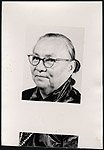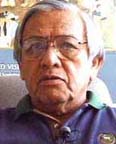Havasupai
Hopi
Hualapai
Kaibab Paiute
Navajo
Traders
Code Talkers
Miss Navajo
Pow-wow
Places
The Long Walk
Livestock Reduction
White Mountain Apache
Save the Peaks!
Merriam Report
Credits

Navajo Chief
Hoskininni (d. 1912), also known as Hush-Kaaney (meaning angry one), governed the remote lands in the Monument Valley/Navajo Mountain region in the current state of Utah. Hoskininni and his band of Navajo resisted the efforts of the United States military to round up all Navajo and force them to march hundreds of miles east, to Bosque Redondo/Fort Sumner, New Mexico (known as "The Long Walk").
Chief Hoskininni and his band avoided capture for four years by hiding out in the remote lands of Navajo Mountain, where perennial springs were located. The group subsisted on pinon nuts, game, and the few sheep they had managed to bring with them when they fled the military. Hoskininni's sound leadership eventually enabled this particular band of Navajo to thrive and prosper in this area. Legend says that Hoskininni and his band discovered silver in the area because of the large amounts of jewelry that the band possessed, noticed by other Navajos who returned to the area after internment at Bosque Redondo ended. However, no silver mine or deposit has ever been found. Hoskininni died in 1912 in Monument Valley, where he lived with his family.
Manuelito (1818-1893) (Hastiin Ch'ilhaajinii) was born near Bear's Ears, Utah into the Bit'ahni (Folded Arms People). This clan was his mother's clan. His father was Cayetano, a Navajo leader. When Manuelito was young, he participated in an ambush against the Pueblo Indians. He earned the war name Hashkeh Naabaah (Angry Warrior). Manuelito has also been called Bullet Hole, for a bullet wound to his chest.
He married the daughter of Narbona, a prominent Navajo peace leader, at the age of sixteen. Narbona was later killed. In 1855 Governor David Merriweather of New Mexico appointed Manuelito the "official chief" of the Navajo after Zarcillos Largos resigned. He was one of the twenty-five leaders to sign the Treaty of 1868. This treaty allowed the Navajo to return to their ancestral homelands.
Manuelito was interested in Anglo-American education because he saw it as a way to better his family's life. His interest in Anglo-American education motivated him to send his two sons and a nephew to the Carlisle Indian Industrial School in Pennsylvania. Sadly, both of his children and a nephew contracted tuberculosis and died of the disease while attending Carlisle School. Manuelito became very sad about his family dying. After his children's death, Manuelito sank into despondency and eventually died.

Navajo Political Leader
Henry Chee Dodge (1857?-1947) was the last official Head Chief and the first Tribal Chairman of the Navajo Tribe.
He was born at Ft. Defiance, Arizona, to a Navajo-Jemez mother of the Coyote Pass Clan. The exact year of birth and the name of his father are not known. At around six years of age, Dodge's mother left home and never returned. Dodge lived with various other family members until there was a mix-up and he was accidentally left alone beside a trail. He met a young girl and her grandfather traveling on the trail, and they adopted him. He was living with this family when, in 1864, he was forced by the United States Government, along with thousands of other Navajos to walk over 300 miles to Bosque Redondo, near Ft. Sumner, New Mexico from their homelands in what is now northeastern Arizona. The Navajo people refer to this forced relocation as "The Long Walk". In 1868 the Navajo were finally allowed to return to their ancestral homes. Upon his return to his homeland, Dodge was reunited with an aunt who had married an anglo. Dodge eventually learned English through his exposure to Anglo culture. He then enrolled in the Fort Defiance Indian School where he learned to read and write in English. He followed the old Navajo custom of marrying multiple wives. It is said that he may have had as many as eight wives at one time.
In 1884 he was named head of the Navajo Police force. Later that same year he was named "head chief" by agent Dennis Riordan. In 1890 he formed a partnership with a white trader, Stephen Aldrich, and opened a trading post at Round Rock, Arizona. In 1892 his trading post was a major part of a conflict between Indian agent Dana Shipley and a powerful Navajo headman named Black Horse. In the end, Dodge skillfully negotiated a peaceful end to the explosive affair. In 1923 Dodge was selected the first chairman of the Navajo Tribal Council. In 1942 he was elected tribal chairman for another term. He was reelected in 1946, but contracted pneumonia soon after and died from the disease on January 7, 1947.
Dodge was survived by five of his six children, one of whom was Annie Dodge Wauneka. She became the first woman to be elected to the Navajo Tribal Council.

Navajo Political Leader
Annie Dodge Wauneka (1910-1997) was born on April 10, 1910 near Sawmill, AZ. Her father was Henry Chee Dodge. He was a Navajo rancher and politician.
She began her education at a boarding school in Ft. Defiance, Arizona at the age of eight. The school experienced a tuberculosis outbreak during the time of Annie's attendance. Annie was in the first grade and even at this young age, she helped the school nurse tend the sick. She was also taught to clean and service the kerosene lanterns. This task was repeated every morning so the lanterns could be lit at night and used in the hallways and rooms of the boarding school. In the sixth grade Annie was sent to the Albuquerque Indian School. Her formal education ended at the end of eleventh grade, but later in life she returned to school where she earned a Bachelors Degree in Public Health from the University of Arizona in Tucson. Annie also received an honorary Doctorate Degree from her alma mater for her tireless efforts to better the lives of the Navajo people. Annie married George Wauneka in October, 1929. After her marriage she began to work closely with her father until his death in 1947. Two years after his death she was appointed as the first woman member of the Navajo Tribal Council. In 1951 she was appointed to serve as Chairman of the Tribal Council's Health and Welfare Committee. In 1956, the Surgeon General of the United States invited Mrs. Wauneka to become a member of the Advisory Committee on Indian health.
The greatest award given to Mrs. Wauneka was the Presidential Medal of Freedom Award. President John F. Kennedy sent her the news in the fall of 1963. The actual presentation was made by President Lyndon B. Johnson because President Kennedy had been assassinated. This award is given as the highest civil honor presented to an individual in peacetime. Men and women who make outstanding contributions to the security of the nation, to world peace or to cultural endeavors are considered as possible recipients for this award.
In 1997, at age 87, Mrs. Wauneka died. Her whole life was dedicated to the betterment of her tribe. A great humanitarian, Dodge fought for human rights, rights that she believed all people were entitled to have. Through her work as an activist, Dodge helped health care move into a modern place, one that would better serve Native American interests and needs. Dodge's past efforts in health care will continue to affect present and future Native needs as well.

Navajo Political Leader
Peterson Zah (b. 1937) led efforts to reorganize the Navajo tribal government. He became the Navajo Nation's first president in 1990.
Mr. Zah was born and raised in Low Mountain, Arizona. This area encompasses the area of the Navajo-Hopi Land Dispute While living at Low Mountain, Zah gained valuable knowledge of his own tribe and living in close proximity to the Hopi brought him valuable knowledge of the Hopi tribe as well.
Education has played a big part in Zah's life. As the keynote speaker at the National Indian Education Association Convention in October 2004, he introduced his mother, Mae Zah recalled the times that he and his mother would have to ride a horse for several miles just to find someone to read letters they received from his father, who was away at work on the railroads. He was glad to finally go to school. At the age of nine he was sent to a boarding school in Phoenix, AZ. Several years later he attended Arizona State University, where he obtained a bachelor's degree in education.
Zah acquired his first political position in Window Rock in 1967. He was hired as the head of the Dine'beiina Nahiilna Be Agaditahe (DNA). The DNA provided legal assistance to the Navajo, Hopi, and Apache Tribes. In addition to this important position Mr. Zah was elected president of the Window Rock Unified School District Board of Directors in 1973, which was the first all Navajo school board. He advocated for more recruitment of Navajo teachers to work on the Navajo reservation.
In 1982 he ran for the position of Tribal Chairman and won. He replaced long term chairman Peter MacDonald for one term. In 1988 he was re-elected, accepting the position of the President of the Navajo Nation under the newly reorganized government structure. He held that position until 1995.
Mr. Zah is featured in the 100 Native Americans who shaped American History, a publication by Bluewood Books. In the Spring of 2005, Mr. Zah earned an honorary doctorate from Arizona State University.